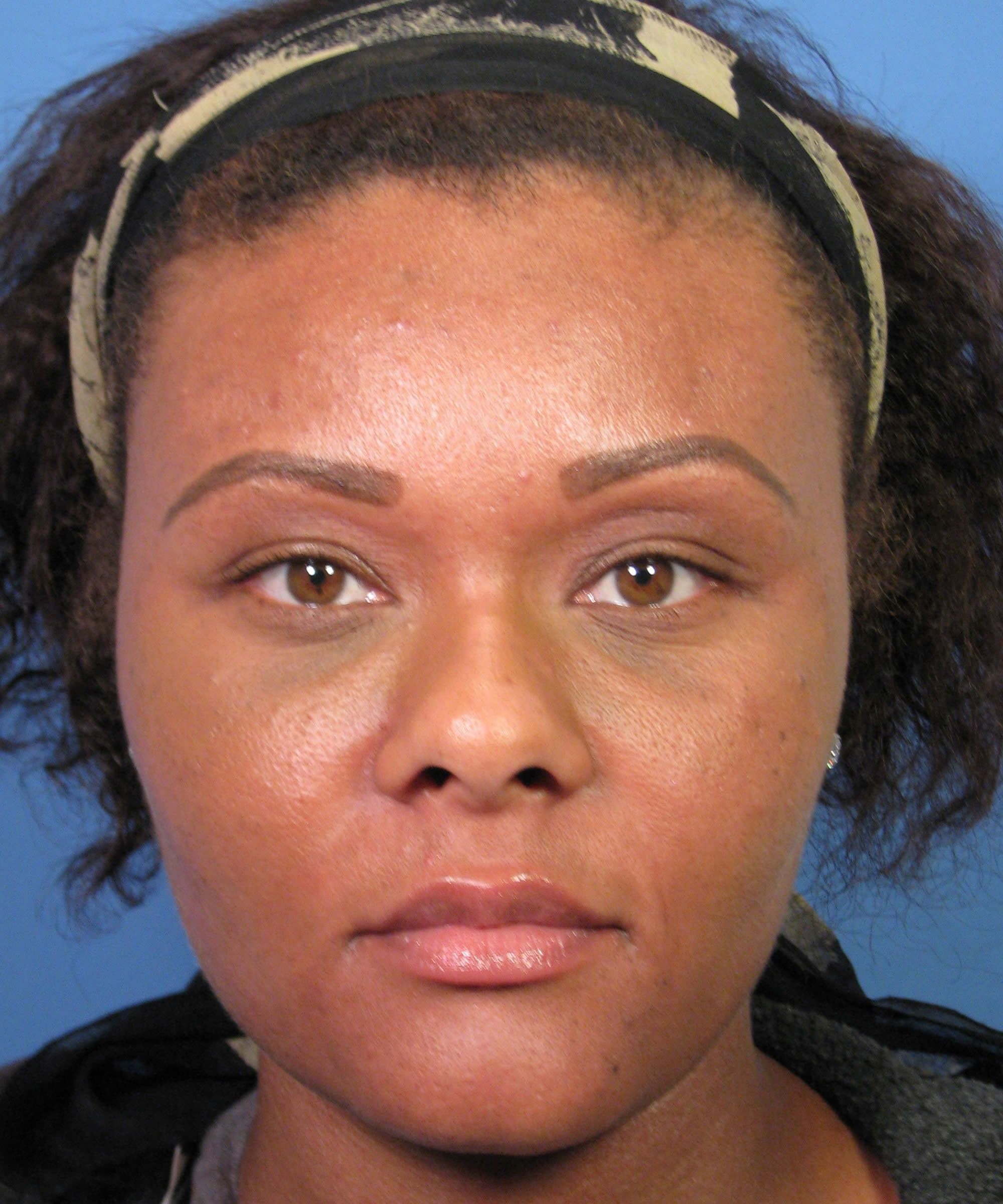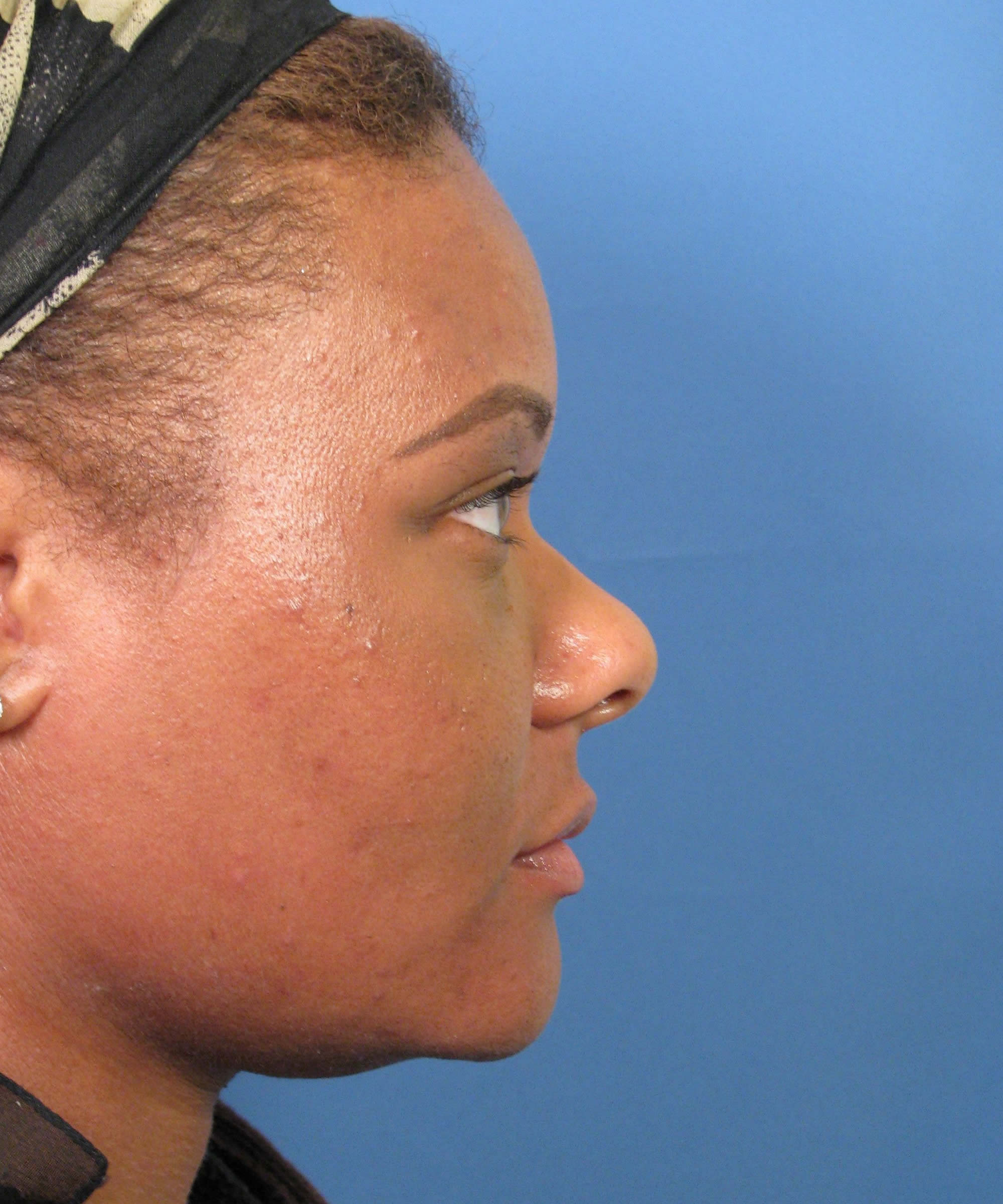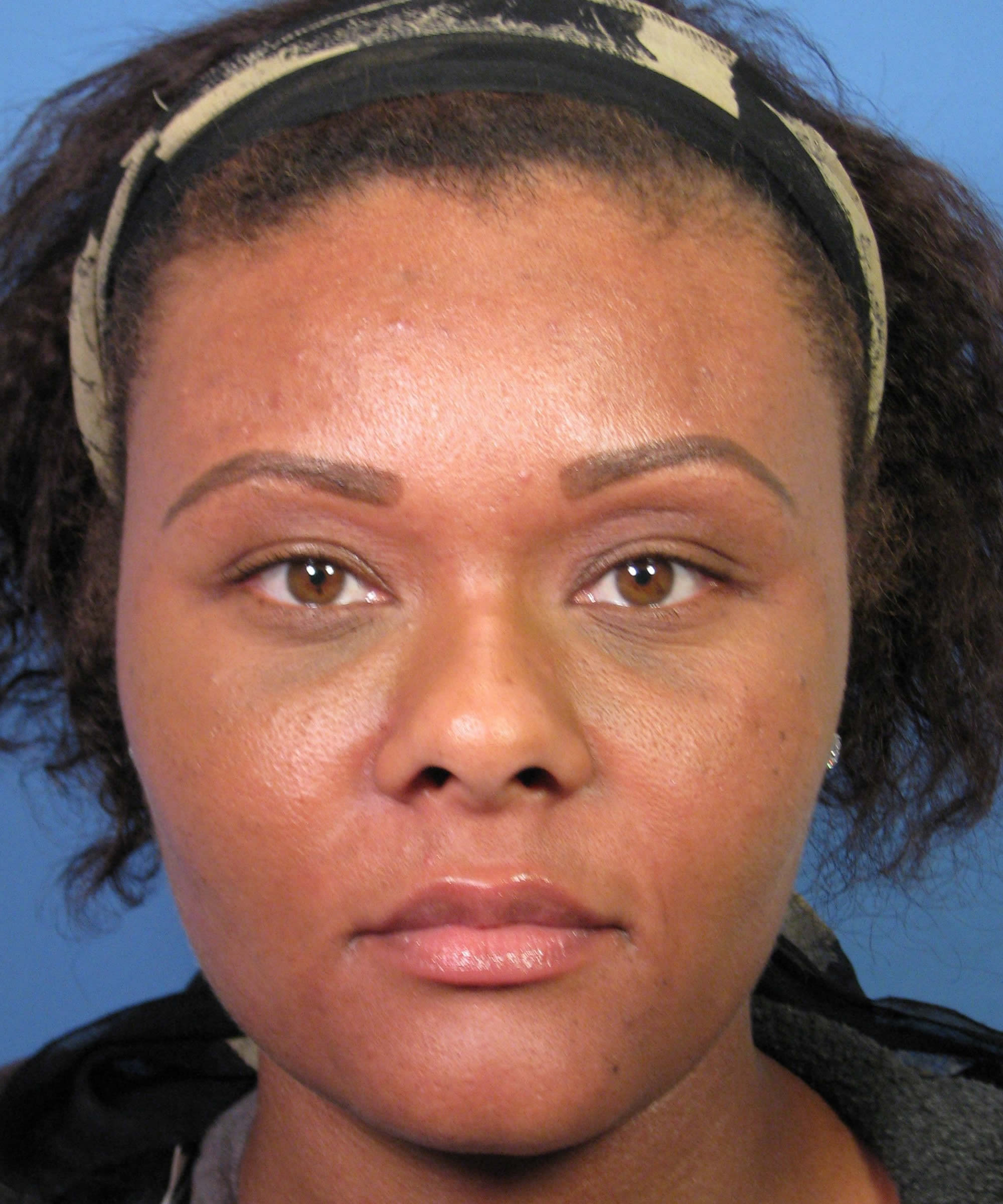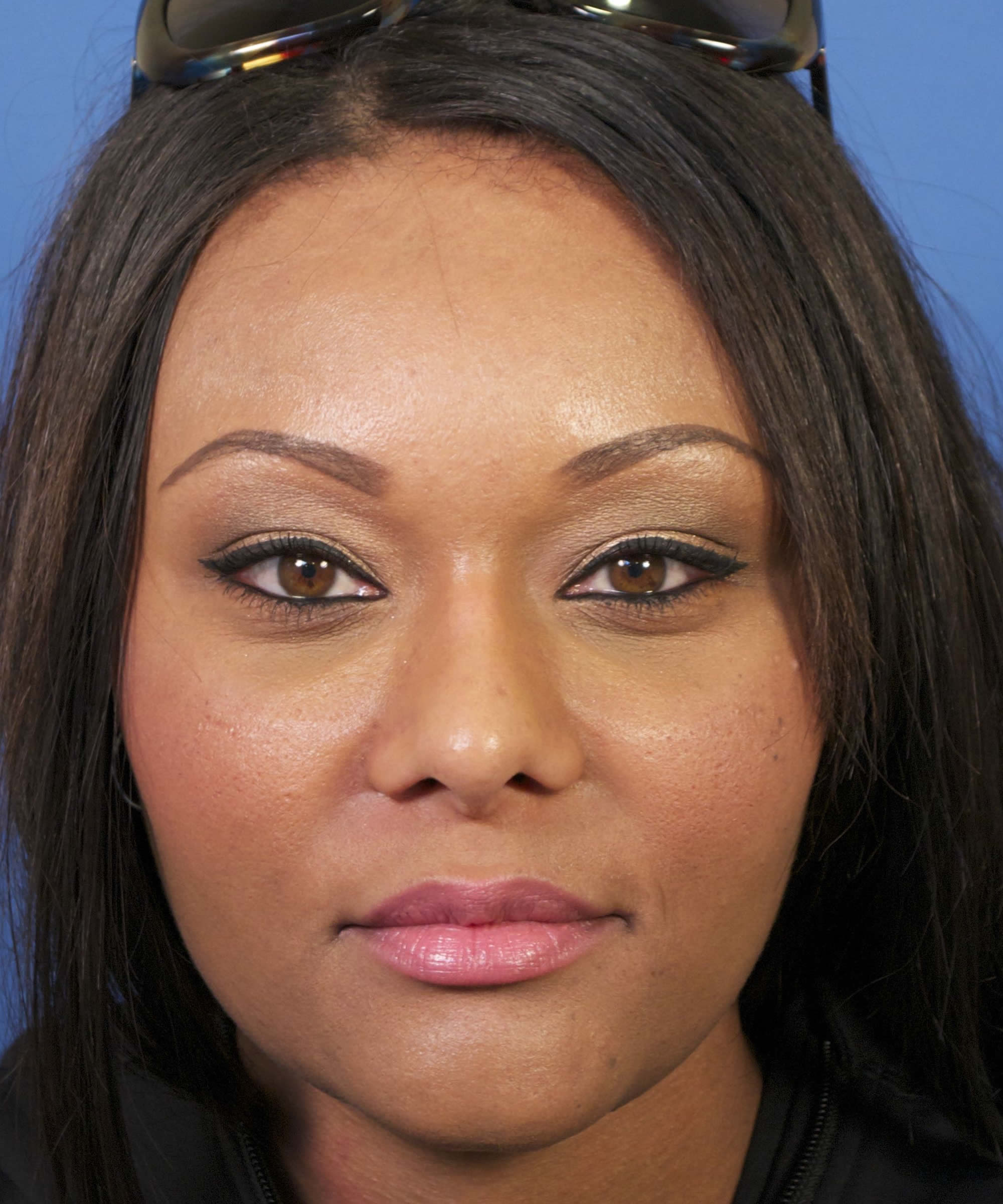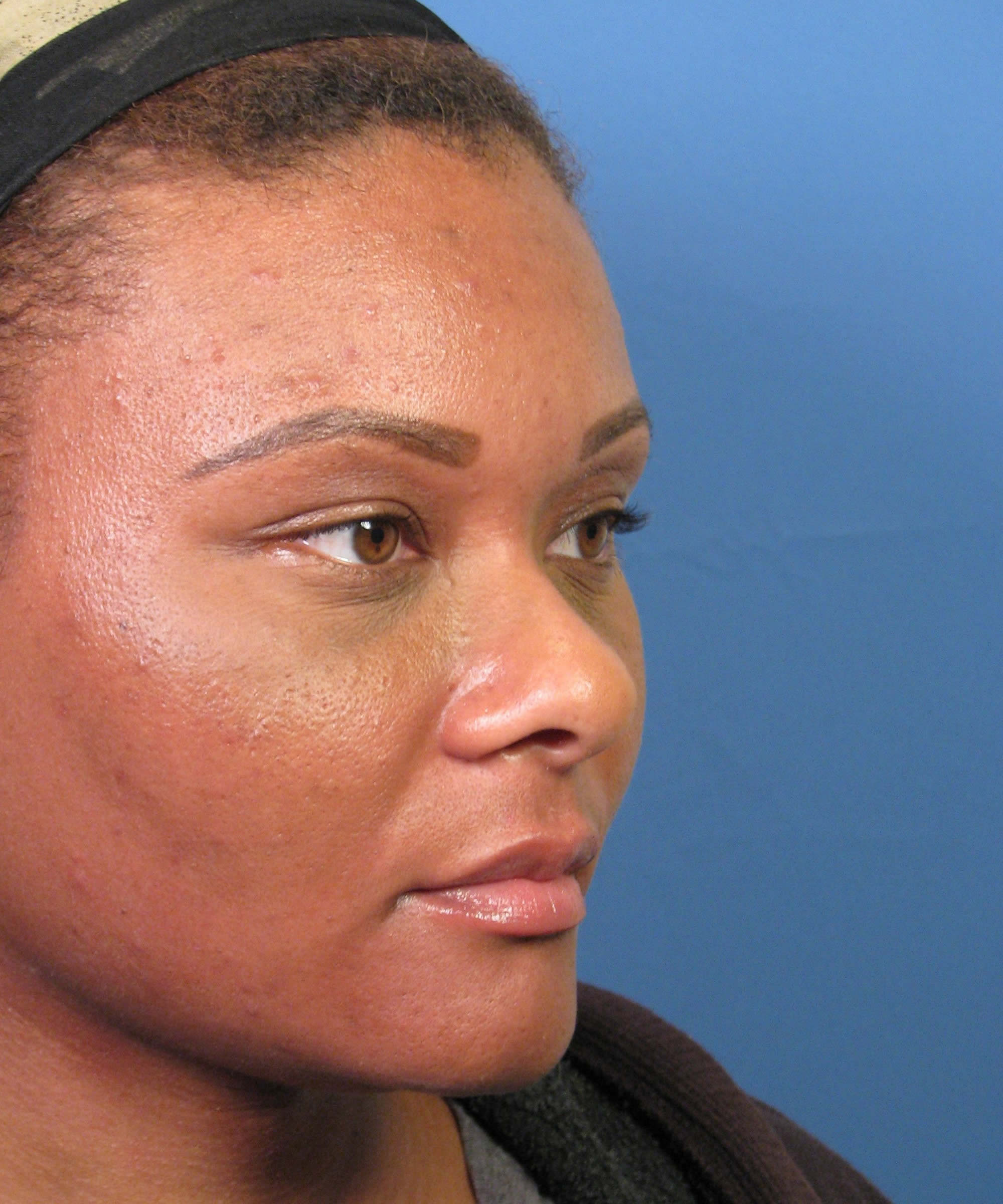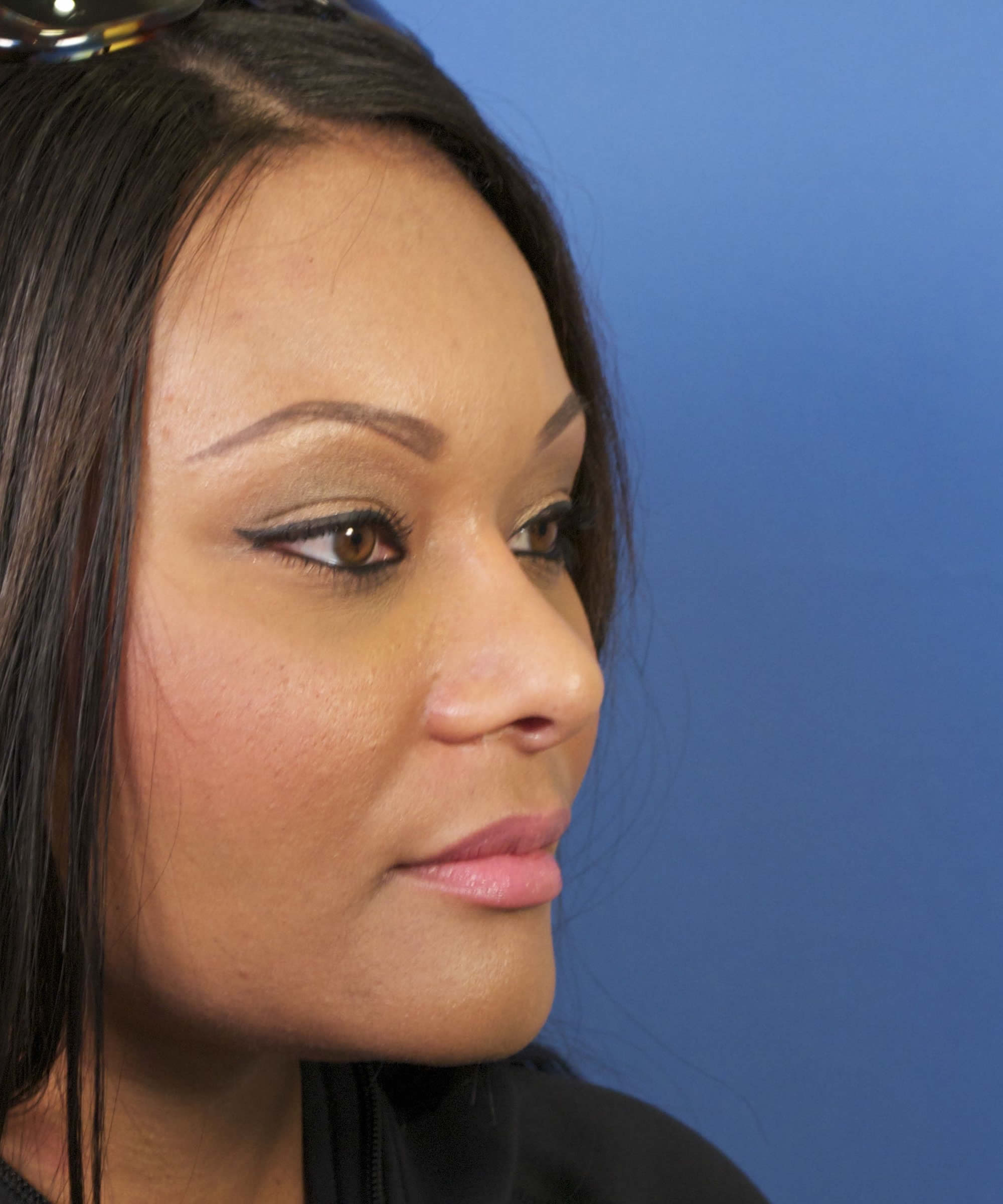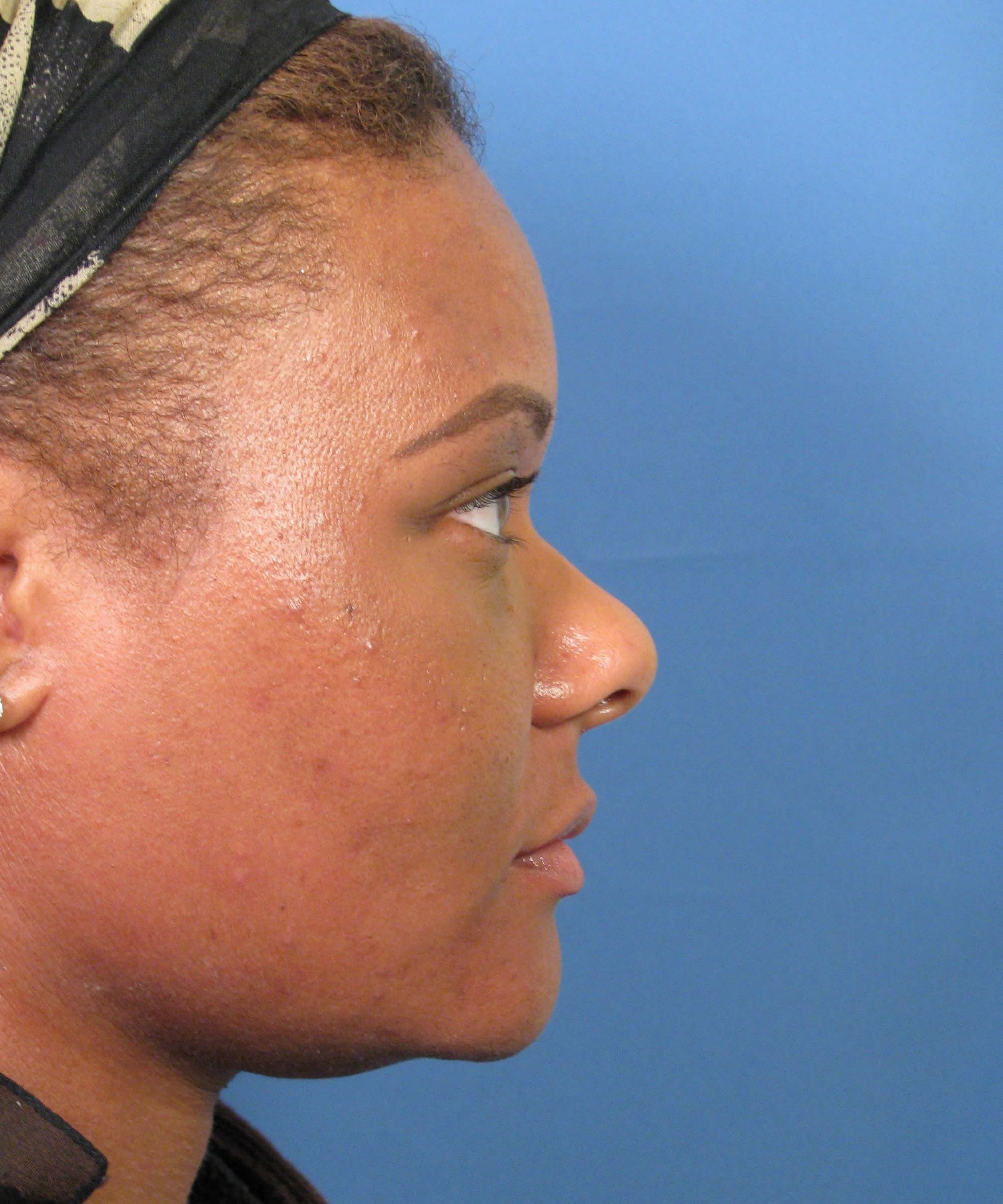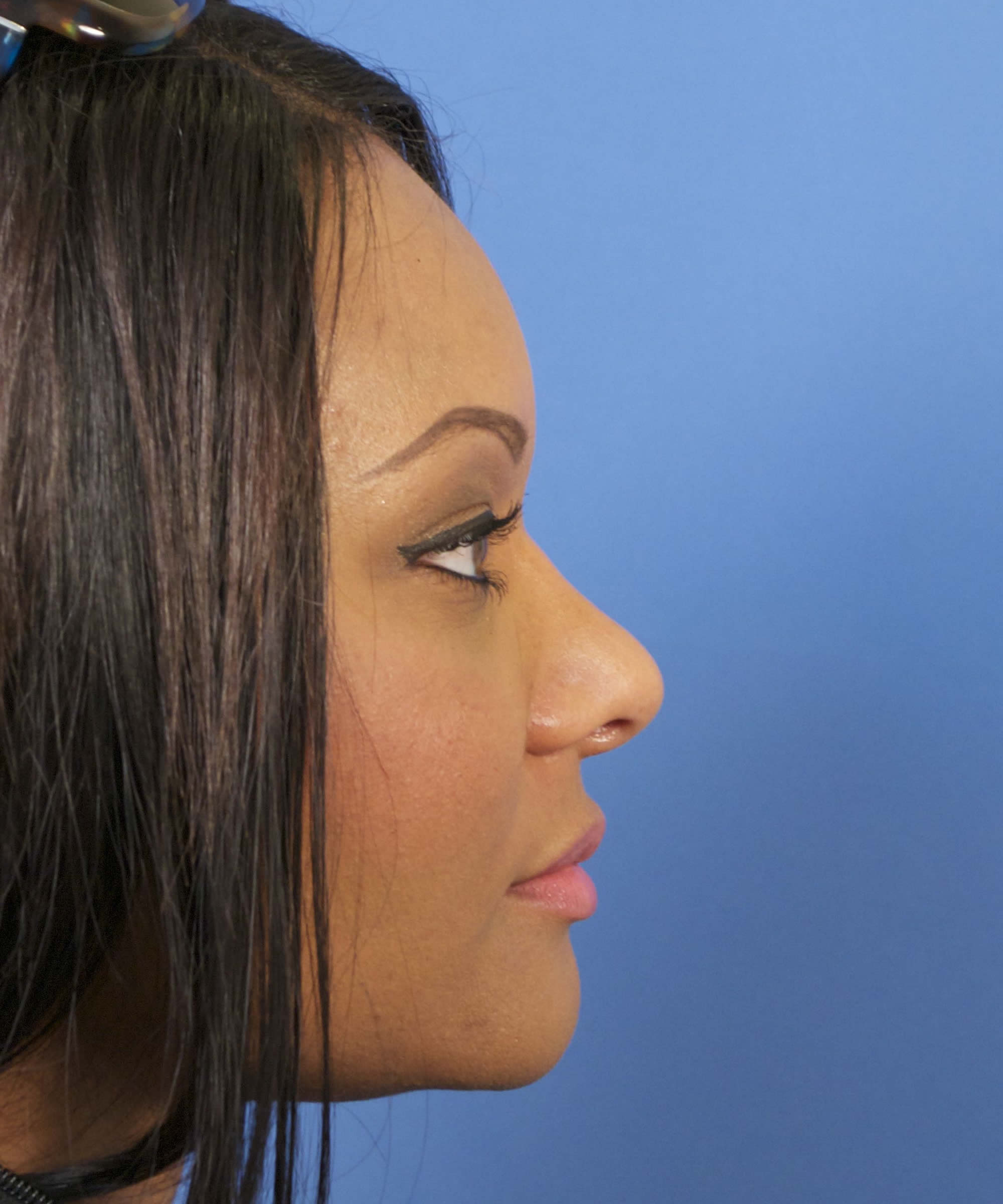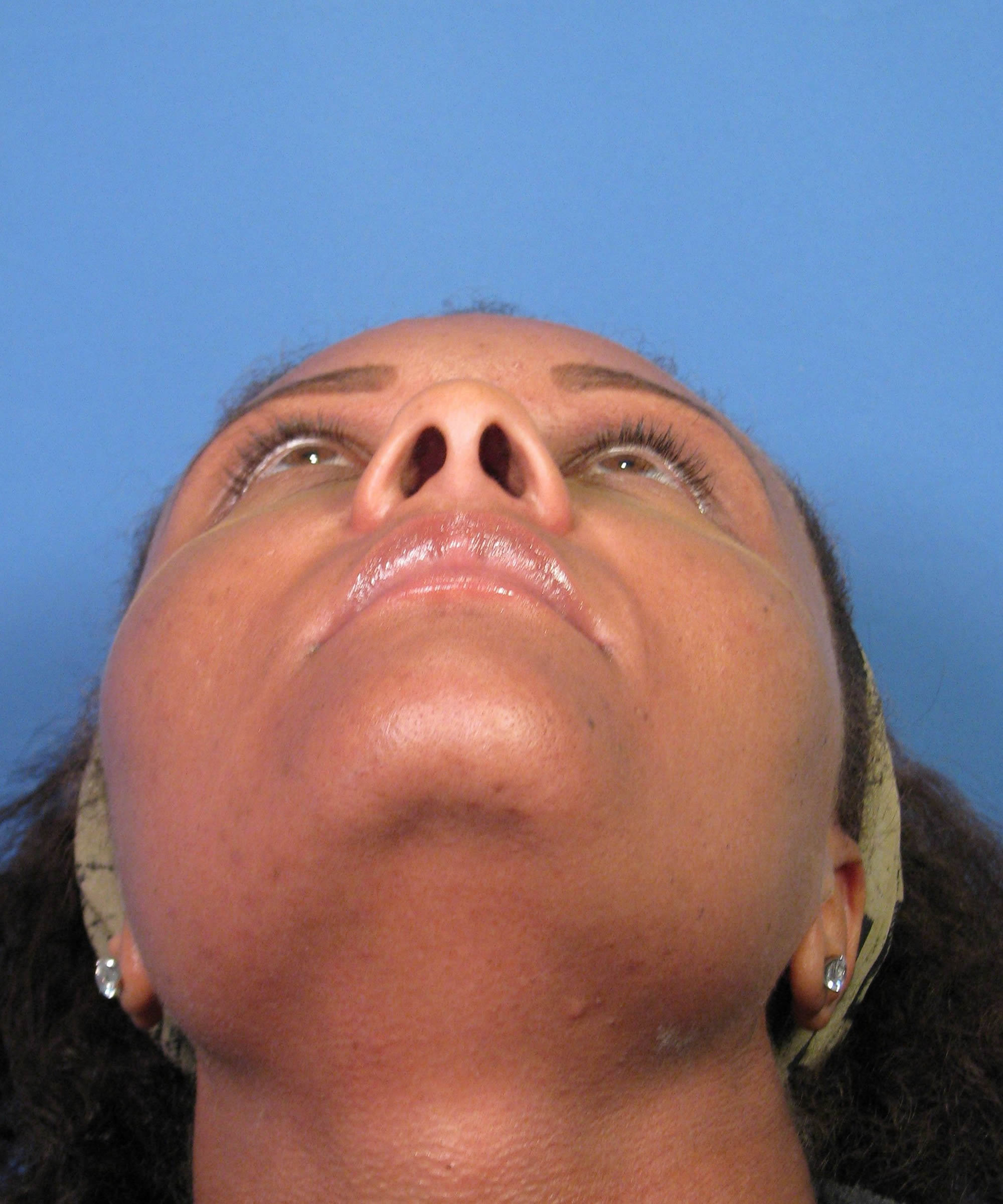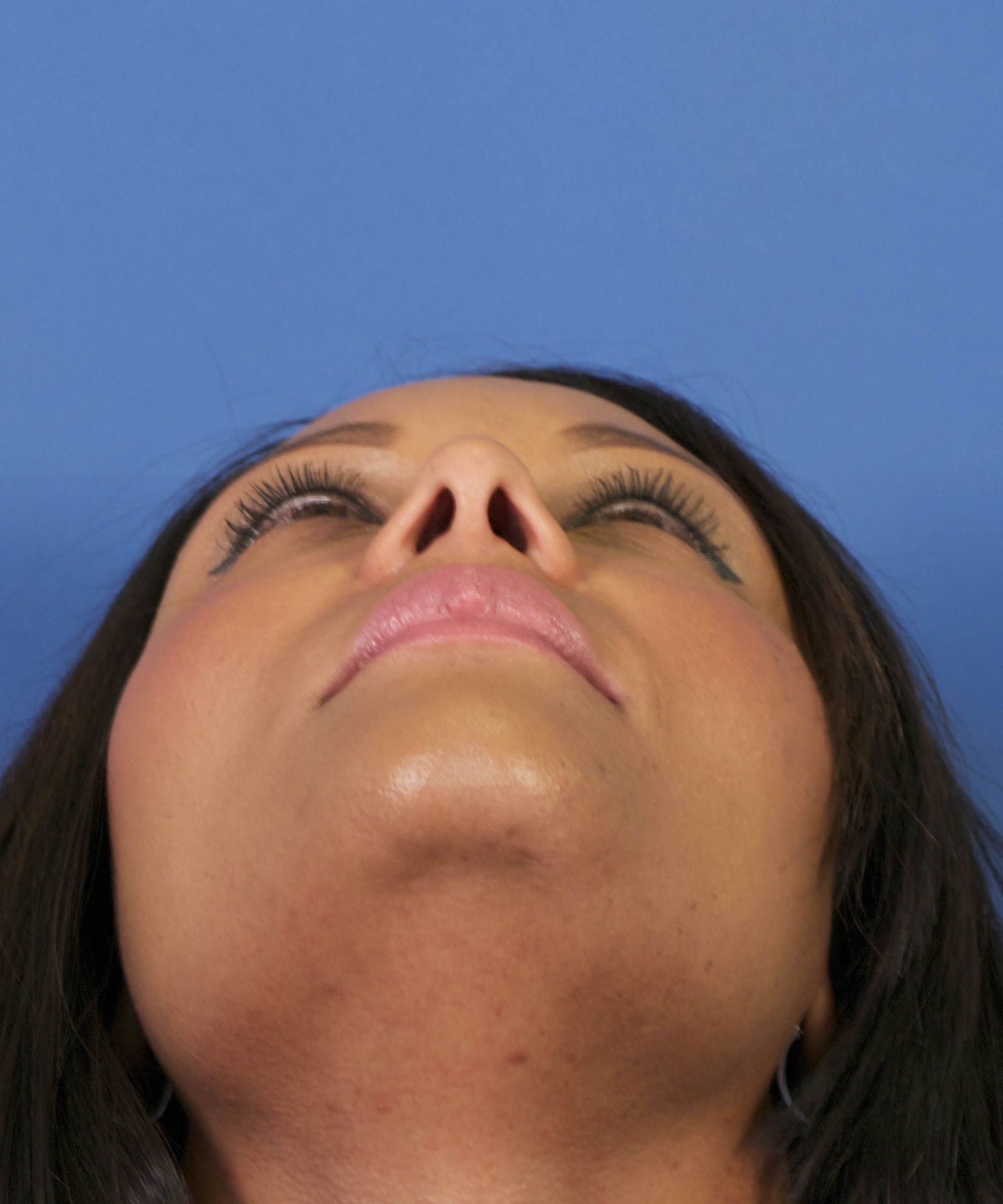This is a great case example that illustrates many of the considerations involved in African-American rhinoplasty (nose job) surgery. Like many African-American rhinoplasty patients seeking nose job surgery, this young lady from San Diego found my office after researching rhinoplasty surgery online. She then schedule a consultation with my office to determine whether or not cosmetic nose surgery was an appropriate choice for her.
African-American Rhinoplasty Presentation
On presentation, her main desire was to have a nose that was more refined through the tip region. But she also desired a higher bridge and more narrow nasal base. Much like many other rhinoplasty patients, she desired these changes, yet clearly wanted to maintain a nose that was ethnically consistent with her African-American facial features.
You can see from the preoperative photos shown here that she had several of the more common characteristics seen in African-American patients seeking cosmetic nose surgery. This included thick nasal skin, a low nasal starting point, a flat, wide nasal bridge, poor nasal tip definition with a bulbous appearance, and a wide nasal base.
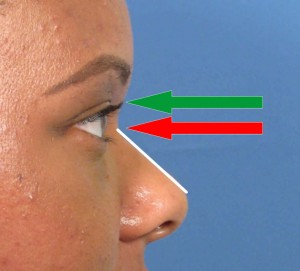 With regard to her low nasal starting point, this deserves a bit more of a detailed explanation. The ‘starting’ point of the nose is typically evaluated from the lateral view as is shown here. In simple terms, this corresponds to the point where the forehead ends and the bridge of the nose begins. Ultimately, the perceived length of the nose is based on where it starts – which is why the nasal starting point can significantly impact the cosmetic appearance of the nose. In cases where the nasal starting is too high, the nose will often times look excessively long. If the nasal starting point is too low, as is the case here, the length of the nose will appear somewhat short. In the latter instance, something needs to be done to lift, or elevate, the upper portion of the nasal bridge in order to change the nasal starting point. In doing so, the perceived length of the nose will be increased as desired.
With regard to her low nasal starting point, this deserves a bit more of a detailed explanation. The ‘starting’ point of the nose is typically evaluated from the lateral view as is shown here. In simple terms, this corresponds to the point where the forehead ends and the bridge of the nose begins. Ultimately, the perceived length of the nose is based on where it starts – which is why the nasal starting point can significantly impact the cosmetic appearance of the nose. In cases where the nasal starting is too high, the nose will often times look excessively long. If the nasal starting point is too low, as is the case here, the length of the nose will appear somewhat short. In the latter instance, something needs to be done to lift, or elevate, the upper portion of the nasal bridge in order to change the nasal starting point. In doing so, the perceived length of the nose will be increased as desired.
African American Nose Job Surgery
During consultation with this patient, a more specific surgical planned had to be devised to raise the bridge height. This is commonly referred to as dorsal augmentation in the rhinoplasty world. In most ethnic rhinoplasty patients, there are several options for dorsal augmentation. These options essentially distill down to two main categories that include the following:
- Cartilage
- Autogenous septal cartilage
- Autogenous ear cartilage
- Autogenous costal, or rib, cartilage
- Cadaveric (tissue banked) costal cartilage
- Nasal implants
- Goretex
- Porex
- Silicone
In terms of cartilage, there are several different potential sources with the septum, ear and rib being the most common choices. Autogenous is a term that simply means the cartilage is taken from your own body. So, for example, an autogenous septal cartilage graft refers to a segment of cartilage taken from inside of the nose (the septum) and placed elsewhere to effectively change the overall shape. In this setting, the septal cartilage would be used to augment, or raise, the bridge height. Cadaveric cartilage is an alternative source that can be obtained from a tissue bank and used for similar purposes in terms of grafting. Some rhinoplasty surgeons prefer to use autogenous rib cartilage, while others lean toward use of cadaveric rib cartilage instead. Because there are advantages and disadvantages with each source, the final decision is one that should be made with your rhinoplasty surgeon only after thorough discussion.
In terms of nasal implants, all of these are comprised of biocompatible synthetic materials that can be substituted for cartilage grafting. Like the various cartilage choices, each of these also has advantages and disadvantages. One of the primary risks with nasal implants is rejection of the synthetic material because it can act as a foreign body once placed into the nose. Fortunately, this is not very common when the patient has moderately thick nasal skin and meticulous surgical technique is used.
In this particular case, we had gone into surgery with the idea that Goretex would likely be used to build up her bridge height. This was largely because most ethnic rhinoplasty patients have an insufficient amount of septal cartilage for complete bridge augmentation. Surprisingly, once I began performing her rhinoplasty procedure, I discovered a more-than-average amount of septal cartilage that could be used to build up her nasal bridge height – obviating the need to use any nasal implant. Not only did she have enough septal cartilage for raising the bridge, she also had a sufficient amount to reshape the nasal tip.
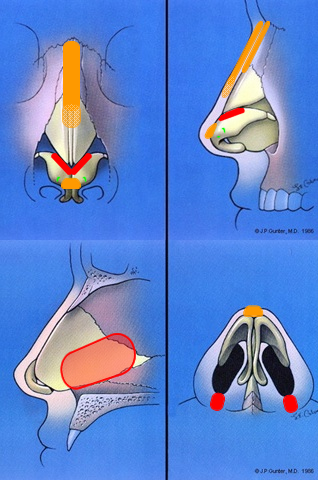 The adjacent rhinoplasty diagram summarizes more graphically the key maneuvers used to reshape this patient’s nose. An open rhinoplasty approach was utilized to gain optimal exposure of the nasal tip and bridge. One of the first steps during her rhinoplasty was to assess whether or not there was sufficient septal cartilage for the planned grafting. As noted previously, there was a surprising amount that was able to be harvested (indicated by the partially transparent red shaded area). This cartilage was taken out of the inside of the nose while preserving an adequate amount to maintain structural support of the bridge and tip. The cartilage was then recycled to produce the various grafts needed to reshape the nose.
The adjacent rhinoplasty diagram summarizes more graphically the key maneuvers used to reshape this patient’s nose. An open rhinoplasty approach was utilized to gain optimal exposure of the nasal tip and bridge. One of the first steps during her rhinoplasty was to assess whether or not there was sufficient septal cartilage for the planned grafting. As noted previously, there was a surprising amount that was able to be harvested (indicated by the partially transparent red shaded area). This cartilage was taken out of the inside of the nose while preserving an adequate amount to maintain structural support of the bridge and tip. The cartilage was then recycled to produce the various grafts needed to reshape the nose.
In order to augment the dorsal height, a layered graft was created and placed over the upper one-half of the bridge. This is represented by the solid orange shaded areas. An additional softer type of graft, called a crushed cartilage graft, was placed just below this area near the middle of the bridge. Crushed cartilage grafts like this are commonly used to help transition the contour in very specific areas.
The same septal cartilage was also used to generate what is called a ‘cap’ graft that was carefully placed in the tip to improve definition. The cap graft was placed only after permanent sutures were used to narrow the native tip cartilage in an attempt to reduce the unwanted bulbous appearance. To further narrow the look of her tip, conservative cephalic trimming was performed (indicated by the solid red shaded areas along the lower lateral cartilages). The cephalic trimming helped to reduce some of the excess volume in the supra-tip region, thus helping to create an even more shapely, refined nasal tip.
Finally, the base of her nose was considered somewhat wide, especially with smiling and animation. This is actually a finding frequently encountered in the African-American rhinoplasty population. In order to help narrow the base, bilateral ‘sill excisions’ were performed. These are shown in the diagram as the red shaded areas at the bottom of the nostril openings. This represents where some of the excess soft tissue was removed from around the nostril opening in order to allow the base of the nose to be narrowed. This type of base narrowing technique is different from what is called a ‘wedge’ or ‘Weir’ excision. The latter involves taking a wedge of soft tissue out of the base of the nose, but closer to where the nose junctions with the cheek. Although both types of base reduction technique are commonly used, they differ in how they will help to narrow the nose.
African-American Rhinoplasty Recovery
Before the results of this particular African-American rhinoplasty procedure are shown, it is worth noting that additional care may be needed during the recovery process following rhinoplasty. For instance, in this particular case example, the patient had slight resorption along the inferior border of the bridge graft. Resorption and warpage of cartilage grafts is a well-known, potential complication of rhinoplasty surgery. Fortunately, it only occurs in a minority of rhinoplasty patients. But when it is encountered, certain additional measures need to be taken to address the issue so that the best possible rhinoplasty outcome is achieved.
As the cartilage reabsorbed, the middle portion of her nasal bridge developed a slight depression that was more easily seen from the side view of the nose. After discussing with her the various options to restore proper bridge contour, we both decided on a non-surgical technique. This involved using a non-absorbable injectable filler, called Bellafill (previously known as Artefill). Over several office visits, tiny amounts of Bellafill were added to the specific location along the bridge where the cartilage had reabsorbed. Gradually, this area was built back up to restore the desired bridge contour and shape. In the end, this option proved to be quite effective while avoiding additional, revision rhinoplasty surgery.
African-American Nose Job Result
This African-American patient’s nose job results are shown here from various angles. Overall, you can tell that she now has a much more refined looking nose. More specifically, her nasal bridge has now been nicely augmented resulting in a nose that now looks longer. In addition, her nasal bridge is now more defined – especially as seen from the frontal view. Just look for yourself how light now shadows in a much more pleasing manner along the sides of her nose. Her nasal tip has also been reshaped to provide a more narrow, less bulbous look. From her base view, you can also readily appreciate how the nasal tip has been refined and the base has been narrowed. The overall effect is achievement of beautiful, soft triangle-shaped nasal tip. Yet, she still has a strong ethnic nose that is consistent with her inherent African-American features.
African-American Cosmetic Nose Surgery
African-American nose job surgery is a very challenging subset of rhinoplasty that should only be attempted by expert nose surgeons, like myself, who have dedicated experience in managing this particular patient population. If you are African-American and considering cosmetic nose surgery, please do not hesitate in contacting my San Diego office today to discuss your options.

